
Guide to strategic decision-making: Tools and techniques to make better business decisions
Reading time: about 11 min
Topics:
Key takeaways:
-
Strategic decision-making is a core professional skill. It involves making the right decision, often quickly, to avoid costly mistakes and lost time.
-
Successful decision-making requires the right tools, preparation, and an inclusive culture. Before implementing other techniques to ensure consistency and effective collaboration, a safe environment for open discussion and a solid understanding of the business's current state are necessary.
-
The decision isn’t the final step. Implementing a feedback loop is also critical. Lucid can facilitate this process.
In an age of constant change, effective leadership relies on responsive and strategic decision-making. Yet our fear of making the wrong choice makes learning that crucial skill set a challenge.
That's why we've created this guide for decision-making—to equip you with Lucid's approach to making better and faster choices. Our goal is to provide you with practical tools and knowledge of decision-making best practices to fuel more confidence and empowerment within your teams.
We sat down with Christopher Bailey and Jeff Rosenbaugh from Lucid’s professional services team to break down their own decision-making frameworks and best practices. Join us as we demystify the process and explain how to make better business decisions.
Laying the foundation: Why does decision-making matter?
Great decision-making skills can make or break an organization. It’s not enough to make strategic moves or fast moves—you need to have sound choices, quick implementation, and the ability to adapt and pivot based on results to succeed.
If it takes teams several months to make an airtight decision, businesses will lose ground to their competitors. If they act too quickly, the choice may be half-baked and lead to mistakes (which cost money to fix). Ineffective decision-making can be draining for CEOs, who report that 35% of their decision-making meetings are inefficient—equivalent to a self-imposed $10 trillion tax on productivity, according to PwC..
There has to be a better way.
For the most creative, well-informed ideas, we have to learn the core professional skill of strategic decision-making.
What is strategic decision-making?
Strategic decision-making involves making choices based on analysis, data, and overall impact on the organization as a whole. To fully maximize the effectiveness of strategic decision-making, you have to focus on making the right choice at the right time. This combination of making an effective decision at the correct time takes strategic planning and intention, which is what separates a strategic decision from a regular one.
Businesses have to align their decision-making frameworks to minimize long-term risk while optimizing short-term gain. That approach is central to the strategic decision-making process.
Diving into the prep work
Before you begin incorporating a new business decision-making strategy, you need to foster the right culture. Having a safe space to express dissenting opinions, generate ideas, and prioritize tasks makes it much easier to take on difficult decisions as a team.
Start by establishing working agreements and documenting them in a shared space like a team charter. Ensure you cover the basics of professional etiquette and team norms, including:
-
Active listening (made easier through strong facilitation)
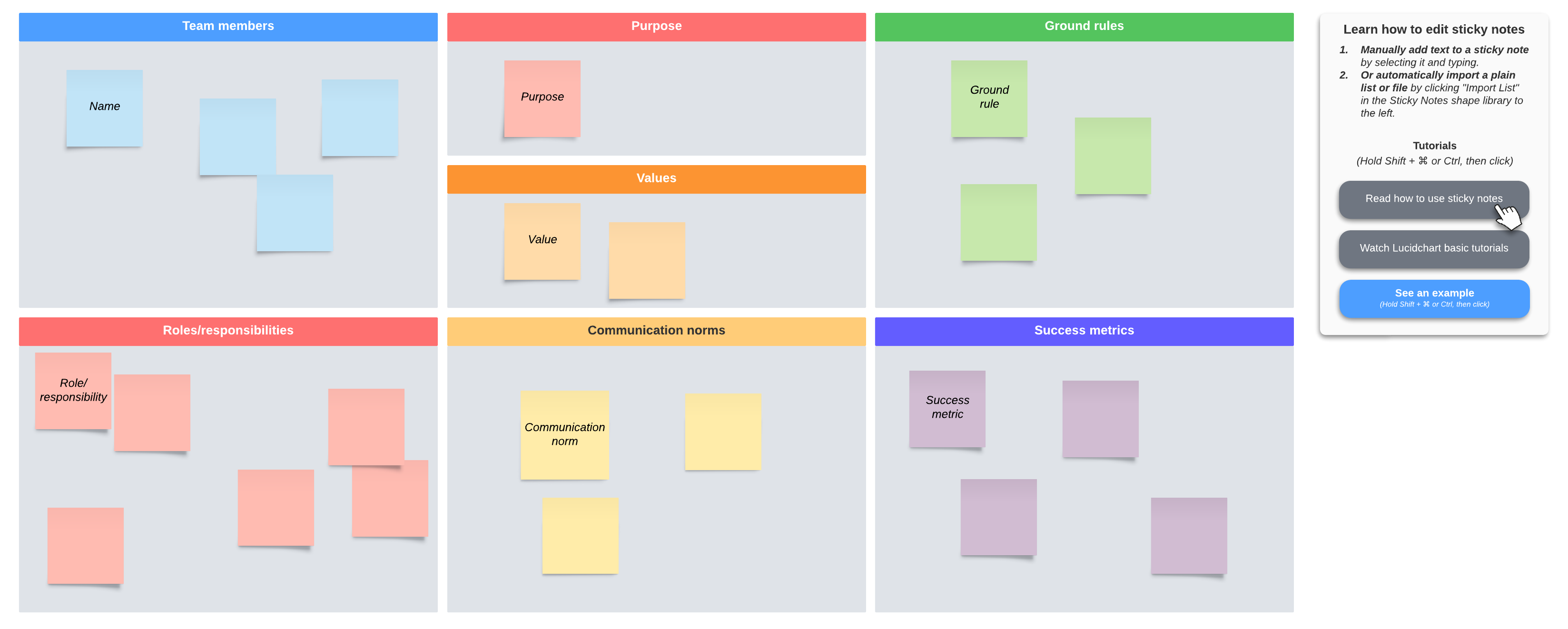
Before you dive into the different decision-making frameworks available, you have to determine the current state of the business, including processes, architecture, and business metrics around OKRs and KPIs.
“In order to make a decision, I need to know what the current state is. Where are we right at right now? How are we progressing toward our goals and objectives as an organization? What new things do we need to consider?” says Bailey, “From there, we pull this collection of information together that can frame a successful decision.”
Mapping out the current state of your processes and visualizing the future state is the way to identify roadblocks and opportunities. Don’t skip this critical step!
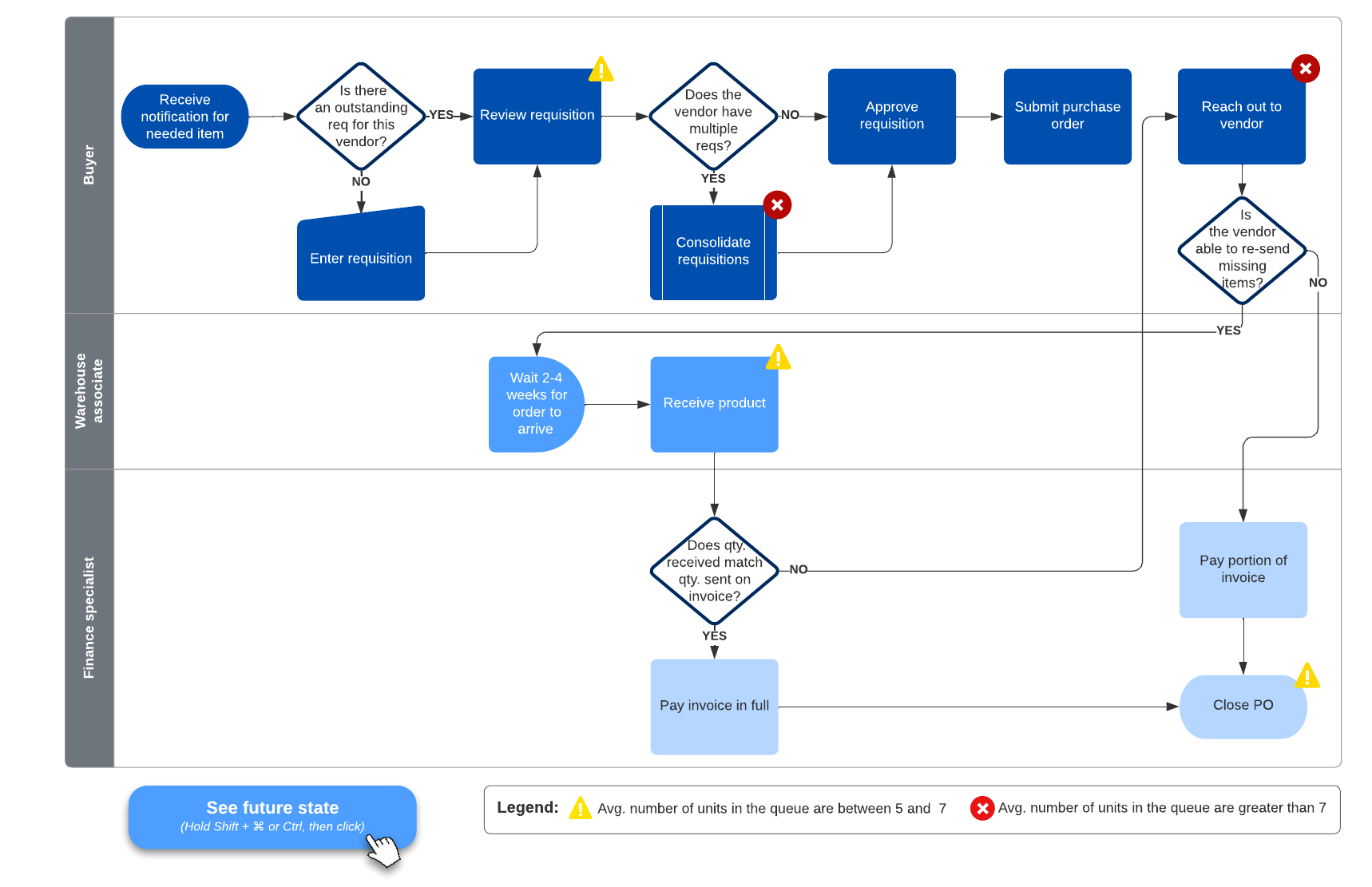
Putting in the framing: The toolkit
The key to making successful decisions is to leverage the capable tools available to you. By harnessing a powerful combination of frameworks, templates, methodologies, and techniques, you will be equipped to confidently tackle complex decisions.
Here are a few other instrumental tools in our decision-making toolkit.
Decision-making and analysis frameworks
When it comes to making efficient and well-informed decisions, it's essential to embrace your inner researcher and gather the necessary information and insights. A research-driven approach empowers you to involve your team early on in the process or arrive at your group decision-making meeting fully prepared to educate participants about the factors shaping the decision.
Gather information—like blockers, value, and associated risk—using an analysis framework. With an analysis framework, you can create clarity with the group on how to make decisions, how to evaluate options, and what data is needed to properly evaluate options.
A decision-making framework promotes consistency in making sound decisions, which reduces the likelihood of errors. It also facilitates post-mortem evaluations, allowing for a structured review of decisions made and enabling continuous improvement.
Here are a few of the best decision-making frameworks available (including links to Lucid templates to get you started):
Consensus approach: This approach involves participants working together to reach a decision that everyone supports. Tools for reaching a consensus include mind maps, decision trees, and dynamic Visual Activities that help you align in seconds.
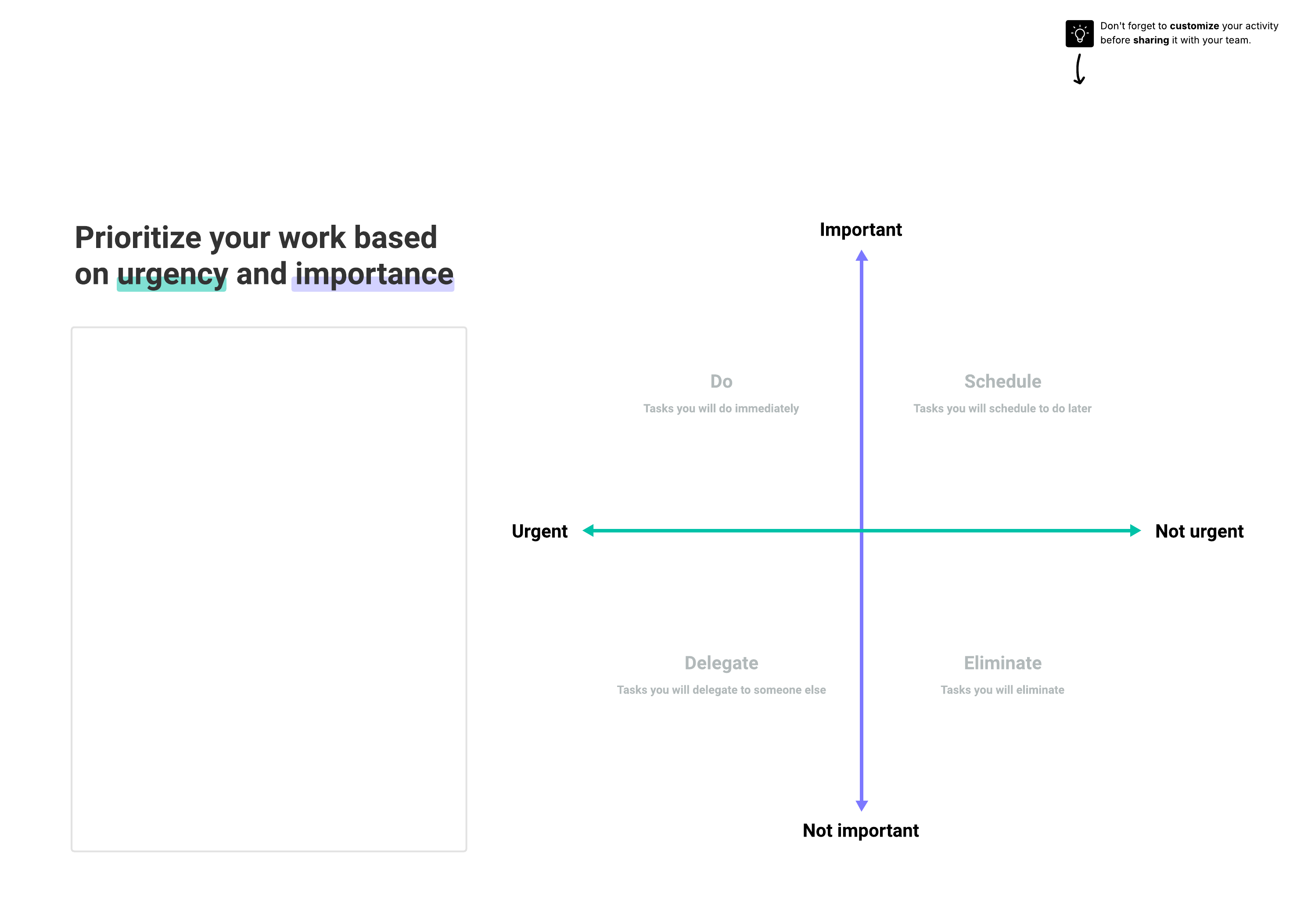
Decision matrix: The decision matrix helps you identify the best solution by comparing alternatives with specific criteria.
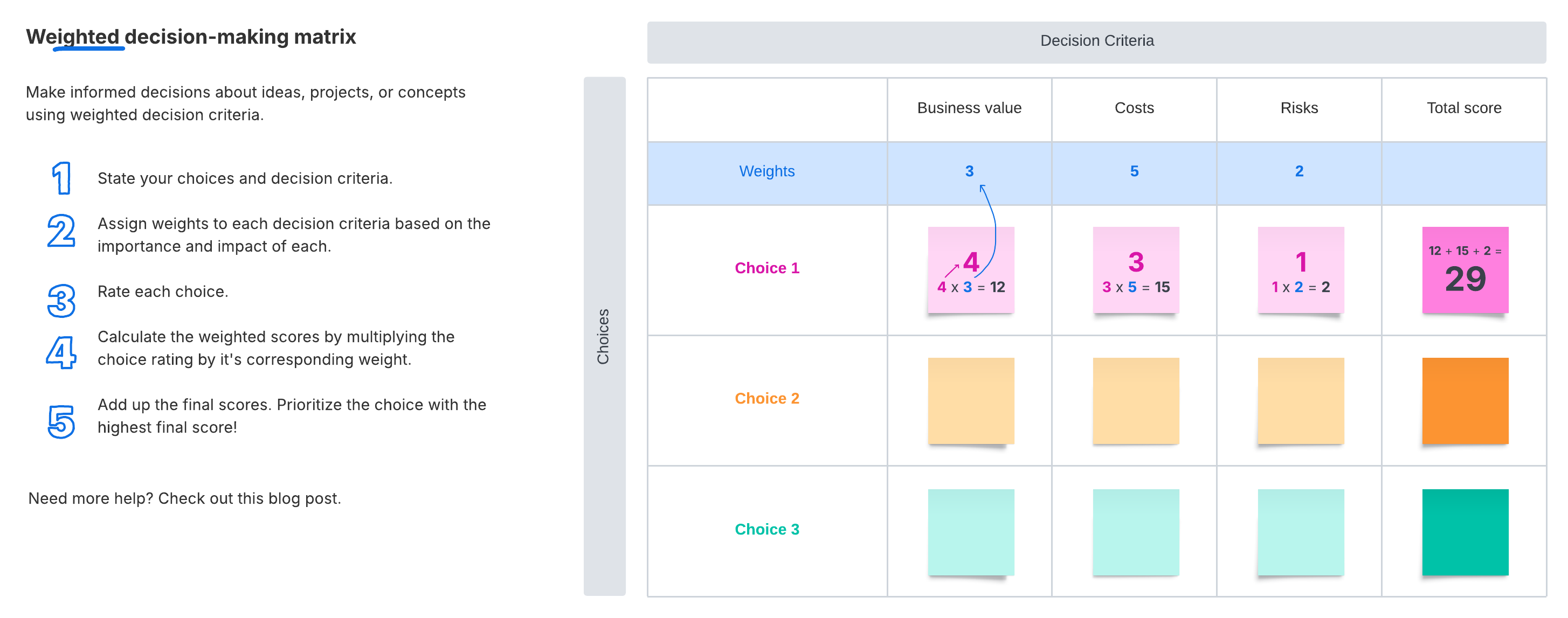
PESTEL analysis: A PESTEL analysis helps you understand which external factors will affect decisions for additional context, like social, environmental, and even political factors.
Cost-benefit analysis: A cost-benefit analysis helps you compare the importance of a decision with its urgency.
SWOT analysis: SWOT stands for evaluating strengths, weaknesses, opportunities, and threats of a particular decision.
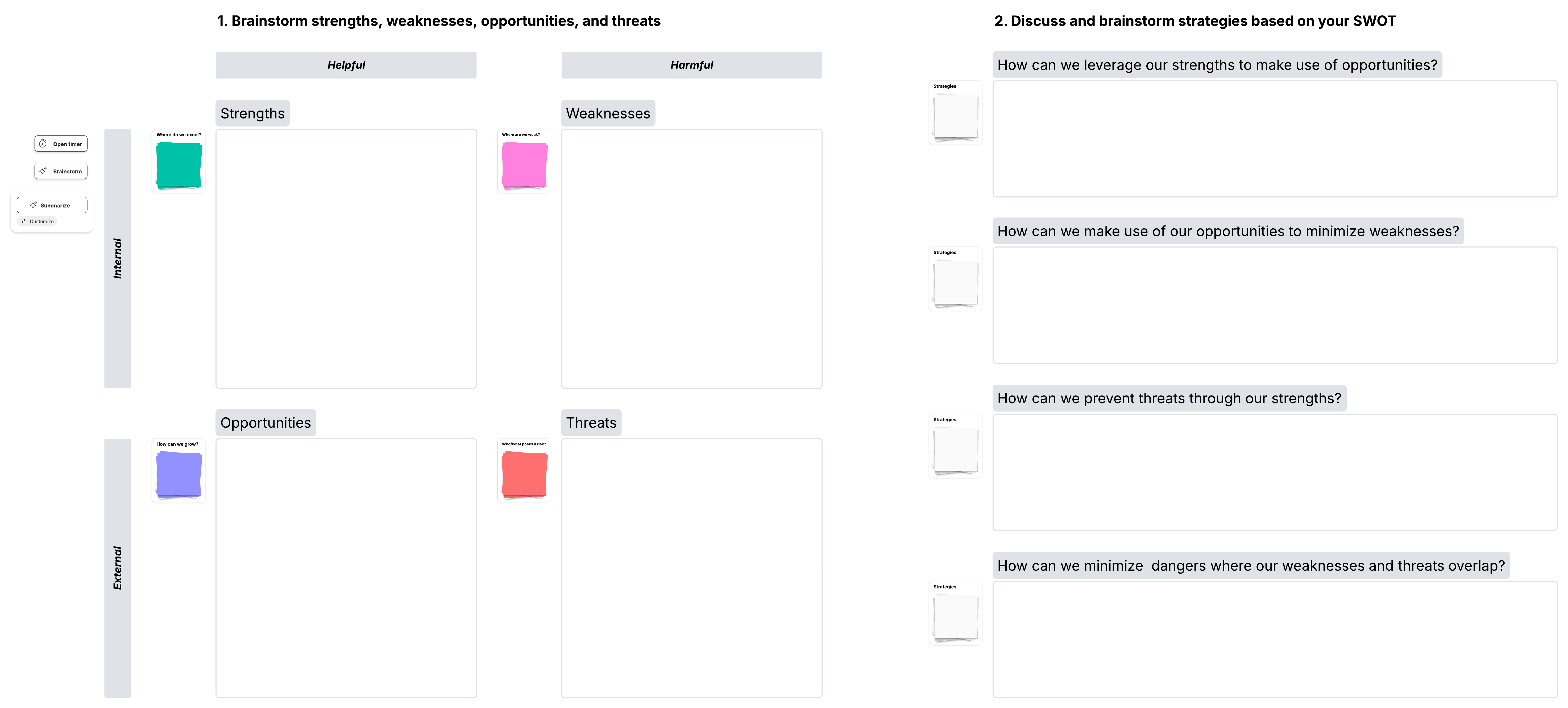
MoSCoW prioritization: The MoSCoW method helps you evaluate what is mandatory, essential, nonessential, and unimportant as you compare options to pick a solution.
Identify the impact: This framework allows you to understand and visualize your decision's impact.
Decision-making techniques
While analysis frameworks are vital to informing your decisions, they’re not as useful when it comes time to facilitate a group decision-making meeting. For that, you’ll need a specific technique to gather input and reach a consensus.
One of our favorite methods here at Lucid, and one that Bailey and Rosenbaugh use regularly on the professional services team, is the fist of five method.
Not only is this technique highly effective, but it is also remarkably simple. Instead of dedicating a significant portion of your meeting time to explaining a complex decision-making methodology, fist of five can be explained and used with a group in just a few minutes. Simply present the decision the team needs to make following a prompting discussion, and team members can indicate their agreement level by raising a specific number of fingers, ranging from one to five. One finger signifies complete disagreement, while five fingers indicate wholehearted agreement. Once everyone votes at the same time (to reduce bias), the facilitator can call out team members with hesitation (represented as votes of two or one) and invite them to voice their concerns. This straightforward decision-making technique can help you gather feedback from your team quickly and easily, regardless of size.

Installing the insulation: Best practices for group decision-making
Group decision-making meetings are often doomed from the start. Without laying the groundwork we’ve covered in the previous sections of this guide, teams are destined to struggle through these meetings and finish without a clear action plan afterward.
After tackling those tasks, you’ll be in a fantastic position to go into a decision-making meeting. This is where the magic happens—where you gather your team, go over mission-critical information, and gather opinions to reach a final resolution.
Here are the three best decision-making tips to help your team work smarter, not harder, to reach an agreement.
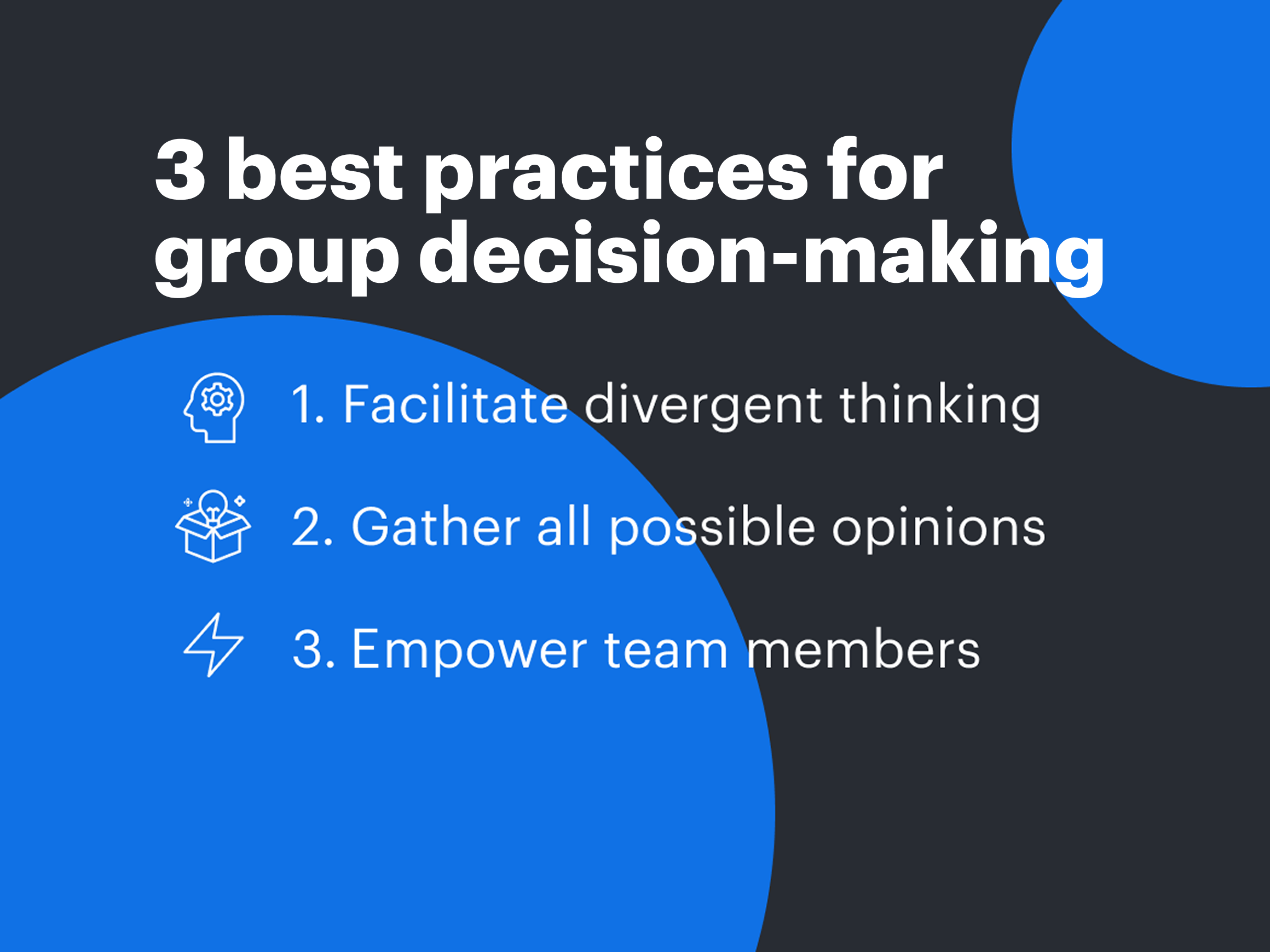
1. Facilitate divergent thinking
Diverse opinions are natural, especially in larger groups or cross-functional teams. Embracing the reality that not everyone will share the same opinion is crucial for effective decision-making. In fact, learning how to navigate disagreements can lead to the most successful outcomes.
Diverse perspectives challenge the group, foster growth, and ultimately enhance the final decision. Embracing and respecting differences in opinion becomes a valuable skill set that extracts the best results from the decision-making process.
“Disagree and commit”
Amazon embraces a powerful philosophy known as "disagree and commit" when it comes to decision-making. In traditional business settings, the aftermath of a decision may be filled with instances of "I told you so" if team members didn’t fully agree with the final choice. That kind of attitude doesn’t cultivate an environment conducive to success.
According to Amazon’s philosophy, leaders have a responsibility to engage in constructive arguments, even against their peers and superiors, while maintaining a commitment to the collective decision.
This concept fosters a culture of open dialogue and continuous improvement, ultimately driving the organization toward greater achievements.
2. Gather all possible opinions (and keep moving when that isn’t possible)
Every voice in the room holds valuable insights that can shape the best possible outcomes. Sometimes, it’s hard to get every participant to speak up, and even harder to visualize everyone’s opinions. These pain points can deter teams from ensuring everyone has a stake in the decision.
“To avoid letting a decision linger forever, one option is to say that if we have a quorum of opinions coming in, then we’re going to trust the group’s decision here. We’re going to trust that everybody else is thinking holistically about this decision,” says Bailey. “Alternatively, you can leverage asynchronous opportunities.”
With a visual collaboration solution, you can facilitate a more inclusive environment that makes participation more accessible. This approach helps democratize input, which keeps it from being dominated by the loudest individual or the stakeholder with the highest title. Understanding the different collaboration styles in the room can be incredibly helpful in facilitating an inclusive space.
Through the power of visual collaboration, you can harness the collective wisdom of your team, foster a culture of inclusivity, and yield informed and balanced decisions.

Learn our best tips for fostering collaboration equity in your organization.
Go nowLowering the barrier to entry
Lucid offers a range of features designed to facilitate seamless input sharing among team members, like Visual Activities. Visual Activities make the decision-making process more approachable and less intimidating, while adding some fun back into your meeting flow. In seconds, collect and synthesize feedback to gain a solid understanding of opinions and perspectives.
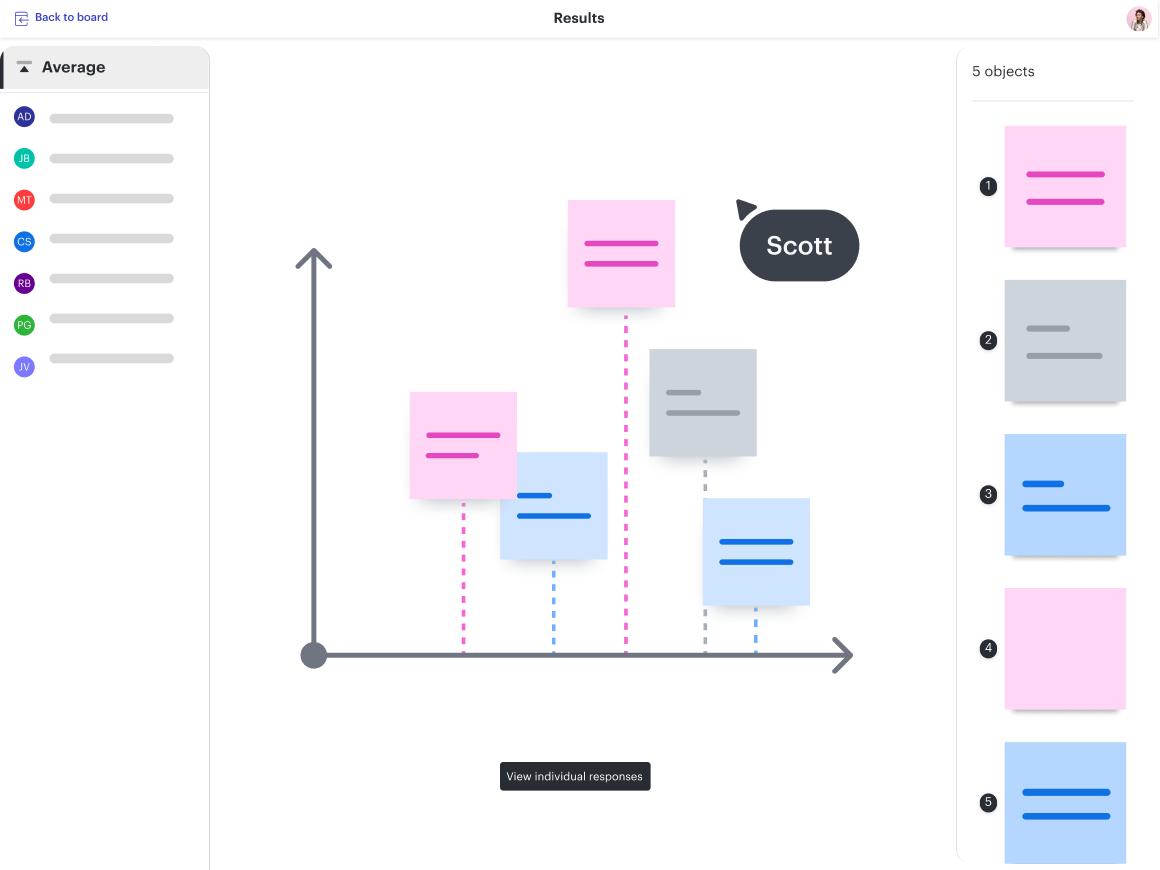
Establishing faith in the group decision
Despite your best efforts to include everyone's input, there may be times when it isn’t possible to gather every single opinion. Team members may be absent due to illness or other commitments and might miss the final verdict. In these cases, facilitating an asynchronous session can be a helpful alternative to gather opinions and ensure participation. But even if team members are absent during the final verdict, trusting the team's judgment to make the best decision for the company is crucial. This is impossible without established trust and rapport.
3. Empower team members
The modern workplace is still divided. Many companies adhere to tradition—centralizing decision-making authority within executives and formal leadership positions. Team members then feel frustrated and disconnected from their own contributions and responsibilities.
David Marquet, a renowned former nuclear submarine commander, is celebrated for his insightful approach to decision-making. He has a simple yet profound philosophy that involves engaging team members in the decision-making process and, most importantly, empowering them to lead out on decisions for themselves.
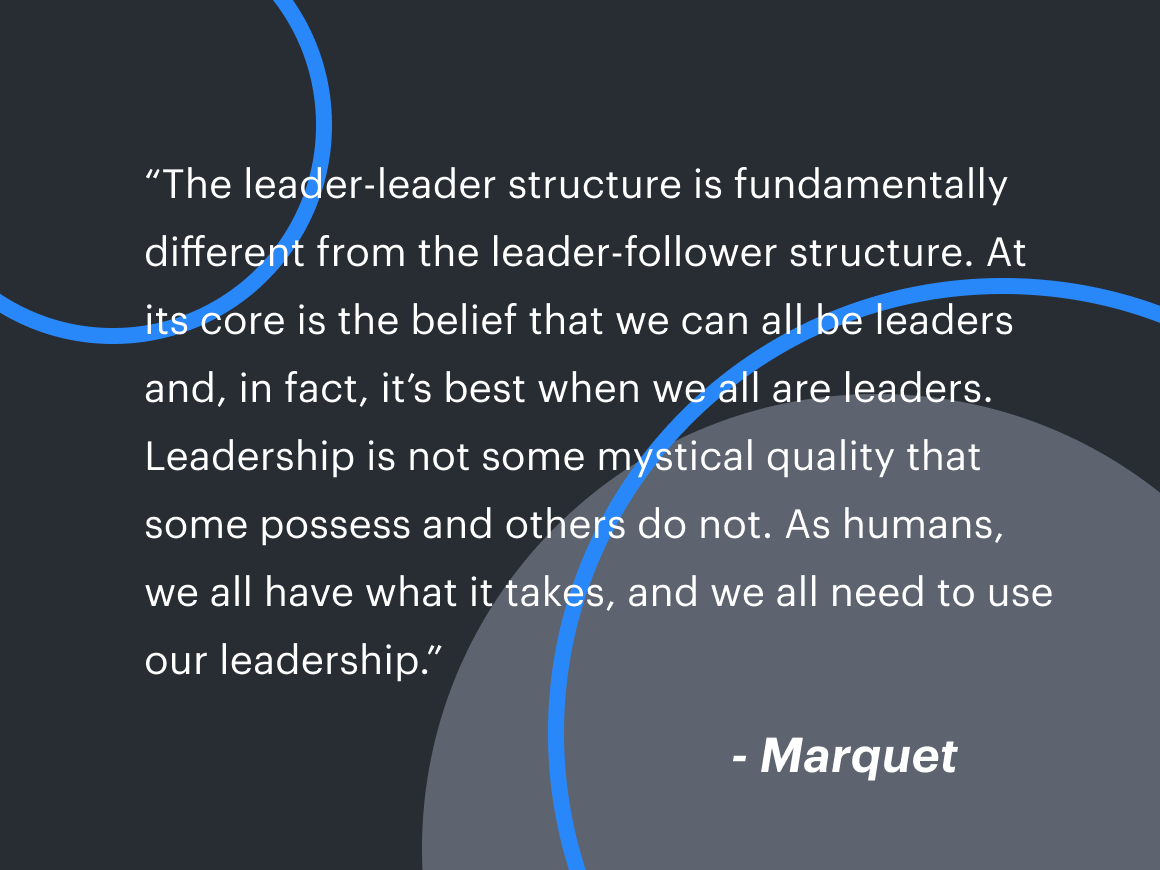
When each team member feels empowered in their own leadership capabilities, a remarkable transformation occurs. They become more inclined to actively contribute their thoughts, expertise, and opinions during decision-making discussions. This inclusive environment naturally fosters divergent perspectives and robust discussions, leading to greater innovations.
Undergoing inspection: The importance of the feedback loop
Surprisingly, making the decision itself is not the most critical aspect of the decision-making process. What matters most is implementing a feedback loop once your team has reached a verdict, which is crucial for learning and improvement.
A feedback loop involves incorporating the results generated by the group’s decision back into your decision-making process at regular intervals. This iterative approach keeps everyone informed and allows for adjustments based on the actual outcomes, which leads to additional transparency, better results, and more informed decisions in the future.
“I say, ‘Let’s measure to see if a decision actually gets us closer to the resulting outcome,’ and then we check in regularly to see if we’re moving the needle or not,” says Bailey. “Depending on that, we have three choices—park, pivot, or persevere. Do we park the work we’ve been doing, pivot towards something totally different, or persevere? This decision constitutes another move through the feedback loop, so we’re constantly moving through it.”
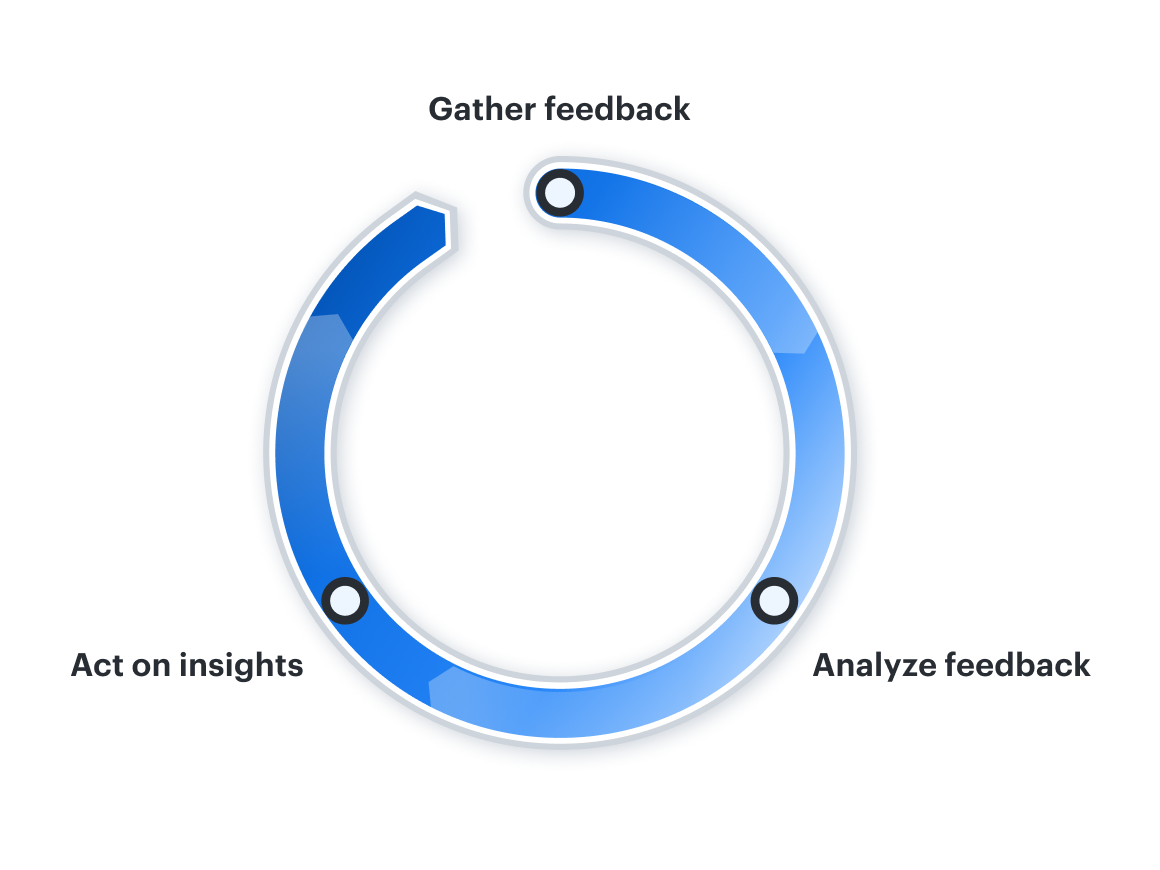
Reflecting on projects and effortless documentation
To gain valuable insights and enhance future projects, scheduling a post-mortem meeting to review the entire project can be beneficial. This comprehensive evaluation allows you to assess the decisions made throughout the process. Additionally, you can leverage the project resources and decision documentation to create more structured and replicable processes for your team, promoting efficiency and continuous process improvement.
Lucid simplifies the transformation of collaboration into documentation. Using Lucid throughout your decision-making and collaboration journey means you’ve naturally generated living documents that capture the entire project's story. These documents play a vital role during post-mortem reviews and regular feedback sessions, providing valuable insights to inform future decisions.

Using the Lucid Visual Collaboration Suite can help your teams make powerful decisions quickly.
Learn howAbout Lucid
Lucid Software is the leader in visual collaboration and work acceleration, helping teams see and build the future by turning ideas into reality. Its products include the Lucid Visual Collaboration Suite (Lucidchart and Lucidspark) and airfocus. The Lucid Visual Collaboration Suite, combined with powerful accelerators for business agility, cloud, and process transformation, empowers organizations to streamline work, foster alignment, and drive business transformation at scale. airfocus, an AI-powered product management and roadmapping platform, extends these capabilities by helping teams prioritize work, define product strategy, and align execution with business goals. The most used work acceleration platform by the Fortune 500, Lucid's solutions are trusted by more than 100 million users across enterprises worldwide, including Google, GE, and NBC Universal. Lucid partners with leaders such as Google, Atlassian, and Microsoft, and has received numerous awards for its products, growth, and workplace culture.
Related articles
Top meeting facilitation skills and techniques for more effective meetings
Explore expert tips and techniques for facilitating more effective, engaging meetings.
All about opportunity solution trees
Learn how to use opportunity solution trees to find the best path forward to reaching your goals. Includes a free template!
5 ways visuals drive better decisions to build better products
Serious about building the future? Then ditch outdated communication methods and use visuals to drive innovation.
How to supercharge your decision-making skills
Strong decision-making skills can help avoid costly mistakes, foster a collaborative work environment, clarify communication, and much more.
